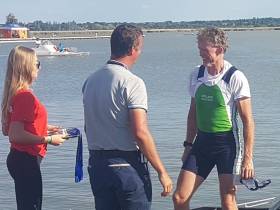Displaying items by tag: Cappoquin
Crowley Leads Ireland to More Masters Wins in Hungary
#Rowing: Irish crews added four more wins to their haul over the weekend at the World Masters Regatta at Lake Velence in Hungary. The wins came on Saturday. Denis Crowley featured in a composite eight, which beat strong British opposition, and in a four – bringing his personal tally to eight wins. Brendan Smyth and Patrick Fowler of Commercial won in the double and Milo and Pat Murray of Cappoquin won the in the pair. A mixed eight finished second on Sunday.
World Masters Regatta, Lake Velence, Hungary (Selected Results; Irish interest; Winners)
Saturday
Men
Eight (E – avg 55 or more): Galway, Belfast BC, Neptune, Clonmel, Commercial, Shannon (G Murphy, A McCallion, K McDonald, D Crowley, F O’Toole, O McGrath, G O’Neill, C Hunter, M McGlynn) 3:04.90
Four (D – avg 50 or more): Commercial, Neptune (B Smyth, F O’Toole, G Murphy, D Crowley) 3:24.72.
Pair (F – avg 60 or more): Cappoquin (P Murray, M Murray) 6:12.10.
Sculling, Double (C – avg 43 or more): Commercial (B Smyth, F Fowler) 3:28.39.
#Rowing: Shandon’s intermediate eight were the fastest crew at the Metropolitan Regatta today. Commercial’s intermediate eight scratched, but UCD’s club one eight gave the young Corkmen a good race – until the final few hundred metres, when Shandon flew away. All of the Shandon crew are junior 18 athletes.
As had been the case in the first session, young rowers came home first in race after race in the superb conditions. Lara Brown of New Ross added the Division One single sculls title to the doubles win she had recorded with Shona Tierney.
Metropolitan Grand League Regatta, Blessington, Saturday (Selected Results; course length between 1750 and 1800m)
Men
Eight – Division One: Shanddon (intermediate) 4:57.91, 2 UCD (club one) 5:02.20. Div Two: Neptune (club two) 5:40.496.
Four – Div One: Commercial A (sen) 5:36.26. Four, coxed – Div One: 1 Commercial (sen) 5:55.01, 2 Shandon (jun 18A) 5:55.99, 3 Commercial (inter) 5:56.41; 5 UCD (club one) 6:02.82. Div Two: UCD A (club two) 5:50.77, 2 Shandon (jun 18B) 5:57.32
Pair – Div One: Commercial (inter) 6:07.65, 2 Commercial (sen) 6:14.6. B Final: 2 Castleconnell 6:25.78; 4 Belfast RC (club one) 6:43.92.
Sculling, Quadruple – Div Two, coxed: Shandon (jun 18B) 5:53.59, 2 Neptune (nov) 5:56.17, 3 Neptune (club two) 5:56.73.
Double – Div One: Castleconnell (jun 18A) 5:47.98; 6 Belfast RC (club one) 6:18.11. Div Two: Cappoquin (club two) 6:03.10; 2 Neptune (jun 18B) 6:03.44. B Final: Commercial C 6:44.69. Single – Div One: Shandon (J Dorney; jun 18A) 6:34.78, 2 St Michael’s (D O’Connor; sen) 6:37.81. B Final: Three Castles (T McKnight; inter) 6:47.52; 5 Commercial (J Casey; club one) 7:11.88. Div Two: Neptune (T Orlic; jun 16) 6:47. 76, 2 Clonmel (O’Donnell; club two) 6:49.48, 3 St Michael’s (O’Gorman; jun 18B) 7:00.84.
Women
Eight – Div Two: UCD (club two) 5:57.43; 4 Commercial (jun 16) 6:39.69. Four, coxed – Div Two: Neptune (club two) 6:56.77.
Pair – Div One: Castleconnell (jun 18) 7:14.24.
Sculling, Quadruple – Div Two, coxed: Commercial (jun 16) 6:51.87, 2 Neptune (club two) 6:54.06, 3 Fermoy (nov) 6:54.57; 6 Commercial (jun 18B) 7:49.09.
Double – Div One: New Ross (jun 18A) 6:43.13; 3 Neptune (club one) 6:48.66; 4 St Michael’s (sen) 7:05.97. Div Two: Carlow (jun 16) 7:11.58, 2 Neptune (club two) 7:36.47.
Single – Div One: New Ross (S Tierney; jun 18A) 7:06.03; 3 Garda (J Ryan; inter) 7:13.48. Div Two: Neptune (J Poh; club two) 7:18.24; 3 Three Castles (E Irwin; jun 16) 7:33.89.
Four and Pair add to Irish Tally at World Masters
#Rowing: The C coxed four of Rob Forde, Patrick Fowler, Oisin McGrath, Gary O’Neill and Tony Corcoran won their heat. The Commercial, Clonmel and Neptune crew beat a Monmouth crew from Britain by almost two seconds.
Milo and Patrick Murray from Cappoquin brought Ireland’s win tally on the day to three when they won in the F Pair.
Earlier an Irish composite eight had won in the E class.
World Masters Regatta, Bled, Slovenia, Day Four (Selected Results; Irish interest; all heats of 1,000 metres, winners only)
Men
Eight ‘E’ (Avg 55 or more) – Heat Three: Waterford, Neptune, Commercial, Belfast BC (A Penkert, J Hudson, D Crowley, G Murphy, M Heavey, C Dickson, C Hunter, F O’Toole, D McGuinness) 3:07.88.
Four, coxed ‘C’ (Avg 43 or more) – Heat Four: Commercial, Clonmel, Neptune (T Corcoran, R Forde, P Fowler, O McGrath, G O’Neill) 3:19.51.
Pair ‘F’ (Avg 60 or more) – Heat Five: Cappoquin (P Murray, M Murray) 3:46.64.

























































